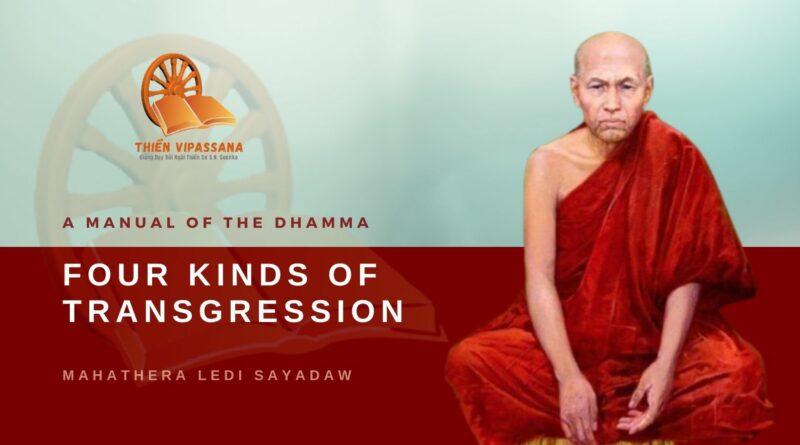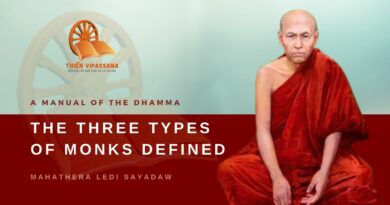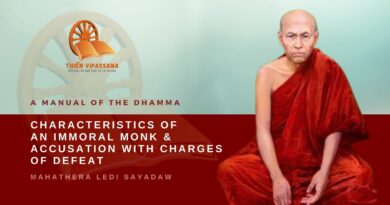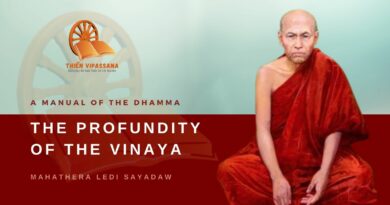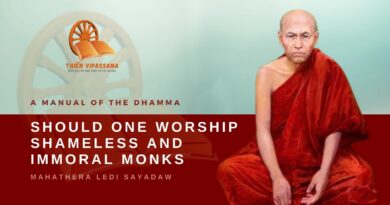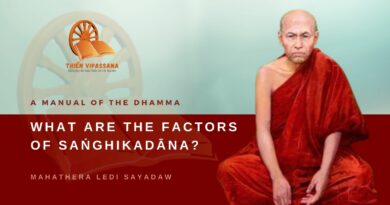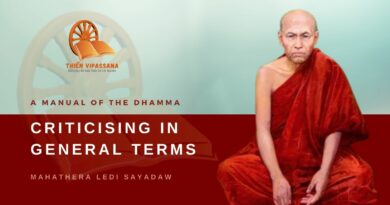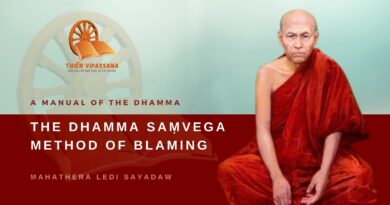Four Kinds of Transgression
The phrase “sañcicca āpattiṃ āpajjati” means intentional transgression of the Vinaya rules (that is, with knowledge of the discipline). In detail, four classifications cover all types of offence:
- Transgression with knowledge of the rule.
- Transgression without knowledge of the rule.
- Transgression with knowledge of the object (things or matter to be transgressed).
- Transgression without knowledge of the object (things or matter to be transgressed).
The explanation is as follows: In the Vinaya Piṭaka, the Buddha prohibited monks from eating ten types of meat.⁴ If a monk breaks this Vinaya rule, he commits an offence. He breaks this prohibition proclaimed by the Buddha for all monks. If a monk knows this Vinaya rule, he achieves the status of one who knows discipline. If he does not know this Vinaya rule, he is classified as one who is ignorant of the Buddha’s prohibition. Both concern the rule in the sphere of “knowing” or “not knowing.” When a monk fails to understand whether any particular meat is allowable, the case is concerned with the object (vatthu). Then he has knowledge or ignorance of the object.
Likewise, regarding the acceptance of gold, silver, and money, a monk may or may not know the rule concerned. Thus, he may be knowledgeable or ignorant regarding the Vinaya. Similarly, regarding the object that should be shunned, classification calls for two cases: knowledge of object and ignorance of the object.
In Vinaya the technical term ‘āpatti’ means fault, offence, committing, and transgressing. Herein, two classes of offence can be found: an offence according to the world, and an offence against the Vinaya rule.
The first type of fault includes killing sentient beings, stealing, and so on. These misdeeds are regarded as unwholesome everywhere so this transgression is known as a fault according to worldly ethical principles.
Regarding the second type of offence, it relates to the breaking of Vinaya rules such as not digging the ground, cutting trees and grass, etc. Such offences, though not evil in the moral sphere of the everyday world, are offences against the Vinaya. The rules for monks taught by the Buddha belong to the faults according to the Vinaya rules for ordained monks.
A detailed examination is necessary for each of these two types.
A monk who has transgressed the worldly prohibition with knowledge and volition becomes a shameless monk. If he breaks a moral principle without knowing it, sometimes he falls into an offence against the Vinaya rule as he knows the object of his transgression. Then he becomes shameless too. Examples of these shameless offences are killing, taking liquor, drugs, etc. He is guilty on both counts, a worldly offence and a Vinaya offence.
However, breaking some training rules occasionally does not amount to a Vinaya offence. Since a monk is free from any offence mentioned in the Vinaya, he cannot be classified as shameless.
Most training rules (sekhiya) and prohibitions in the Mahāvagga and Cūḷavagga Vinaya texts are not offences if one is unaware of them, even if one transgresses the rule. If one knows the rule, but one is ignorant concerning the object, it is an offence against some rules, but not all. In breaking a rule while ignorant of the object, though an offence is sometimes committed, a monk is not thereby shameless. An example of this is a monk drinking liquor. If a monk does not know that he has taken liquor, thinking it to be medicine, it is an offence. However, he cannot be called shameless even though he commits an offence. If a monk kills a sentient being not knowing it has life, he destroys life unintentionally. In this case he does not transgress the Vinaya rule, and he is not shameless either.
A monk becomes shameless only when knowledge of the rule and knowledge of the object are both present. In breaking the rule with knowledge of the rule, but ignorant of the object, he is not shameless. Likewise, a monk remains scrupulous if knowledge of the object is present, but he is unaware of the rule. He does not become a shameless monk. If he knows neither the rule nor the object, and commits an offence, he cannot be called shameless.
The above explanation is given to clarify the meaning of “intentional transgression of the Vinaya rules,” and to show the characteristics of a shameless monk.
The second factor is “āpattiṃ parigūhati,” which means that when transgressing the Vinaya rules a shameless monk conceals his fault. Concealing is characterised by ten factors as follows:
- Transgression of the Vinaya rule or prohibition.
- Knowledge of transgression or guilt.
- Presence of a well-wisher (a monk) nearby.
- Presence of a companion monk among them.
- Absence of any danger.
- Awareness that there is no danger.
- Physical possibility exists to cure or purify the offences by confession and following the procedures laid down for that offence.
- Awareness that physical competence in making confession exists.
- Presence of an attitude to cover up the fault until after dawn.
- Hiding the fault until after the next dawn.
If the above ten factors are present until the following morning, a new offence of wrong-doing (dukkaṭa) is committed, adding to the previous offence. Moreover, a monk thereby becomes shameless. However, if one of the ten factors is lacking, a monk should not be called shameless.
Note that if a monk has all the necessary factors to confess his offence, but fails to do so, he becomes shameless until the confession is made. So a monk may remain shameless for one day, one month, one year, ten years, etc., unless he confesses the offence and follows the prescribed procedure voluntarily. This is a significant point.
The second factor, which says “he knows he has transgressed the rules,” applies to those who do not know the Vinaya rules. Among untrained, ignorant monks, many will not be aware of their faults even if they break the rules. A few monks may not be aware of transgressions at all, while the majority may not know the rules in detail. The reason is a lack of training in Vinaya. Transgressions without awareness are not offences for such monks. So no charges of shamelessness should be made against them.
This is the explanation of the term “āpattiṃ parigūhati.”
For the third factor the text mentions four features: he does not take a wrong course through desire, ill-will, delusion, or fear.
These four wrong courses must be considered, especially in the matter of the distribution of communal property and alms (saṅghika). Scrupulous monks should be free from these four faults as explained in the commentarial literature. However, one should note that partiality, prejudice, bribery, and corruption relate to offences only. The Vinaya teachers say that these four faults arise only when one first breaks a rule, then follows a wrong course due to bias.
However, the arising of this guilt is very subtle. In cases requiring a decision of guilty or not guilty, both sides try hard to win the case, quoting Vinaya, Sutta, and Abhidhamma. However, it often happens that one side, though knowing the correctness of the other, does not admit it and continues to argue to establish the fault of the opposite party. This unfortunate behaviour arises due to pride, conceit, and attachment. One side, lacking humility, claims its views to be according to Dhamma, though this is unwarranted. Similarly, the other side, due to pride, argues that an offence is no offence. Some proclaim no offence to be an offence. By doing so, each side commits the evil of false speech, or lying. This is the offence of taking a wrong course. This fault often arises when one quotes Vinaya, Sutta, and Abhidhamma for one’s own ends in dispute, disregarding the truth. So false speech is classified as a wrong course. This explanation concerns the phrase “agatigamanañca gacchati” — taking a wrong course, the third factor mentioned above.
When it comes to classifying as scrupulous or shameless, those who lack knowledge of the Vinaya keep only a few precepts. So these monks have little chance of becoming shameless.
Those who are well-versed in the Vinaya, attain eminence or conscientiousness in morality. However, if non-observance prevails among monks well-educated in the Vinaya, the likelihood of becoming shameless is great. If a monk, who is well-trained in the Vinaya, accumulates many followers and great material wealth, he can do much damage to the Buddha dispensation, unlike an ignorant monk. This well-educated monk is like an armed robber or thief who enters a treasure-house and steals its contents.
Here ends the section on the characteristics of scrupulous and shameless monks in brief.

